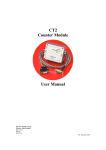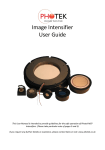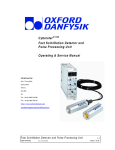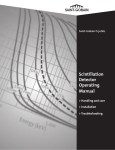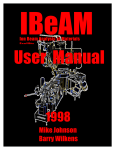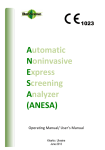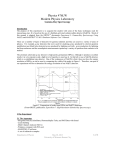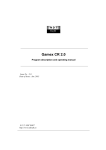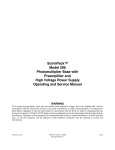Download user manual
Transcript
SENS - TECH SENSOR TECHNOLOGIES P25USB P30USB photodetector modules Sens-Tech Limited 6A Langley Business Centre Station Road, Langley, Berkshire, SL3 8DS, UK tel: +44 (0)1753 214714 fax: +44 (0)1753 214715 email: [email protected] www.sens-tech.com registered in England 668759 an ISO 9001 registered company © Sens-Tech Limited, 2010 the contents may not be copied or disclosed to any unauthorised third party without written permission user manual issue 2 september 2010 SENS - TECH SENSOR TECHNOLOGIES P25USB P30USB photodetector modules page 1 2 3 4 precautions 1.1 light exposure 1.2 supply voltage 1.3 maintenance 1.4 cleaning 1.5 environment 1.6 magnetic fields 2 2 2 2 2 2 installation 2.1 system requirement 2.2 software installation 2.3 interfaces 2.4 light collection 3 3 3 3 start-up software 3.1 selecting module 3.2 control window 3.3 counter/timer window 4 5 7 programming 4.1 command description 9 5 troubleshooting 12 6 module design 13 7 photon counting techniques 7.1 operating principles 14 appendix appendix A - interface characteristics appendix B - environmental conditions appendix C - outline drawings ® appendix D - the ActiveX control 17 18 19 20 8 P25USB, P30USB user manual - issue 2, September 2010 © Sens-Tech Limited, 2010 page 1 of 21 SENS - TECH SENSOR TECHNOLOGIES 1 precautions 1.1 light exposure The photodetector module is extremely sensitive to light. It is recommended that the module is stored in the dark. Exposure to bright light, such as fluorescent lighting or daylight, should be minimised. After exposure to bright light, the dark current or dark count rate may take up to 24 hours to return to the expected low level. note: the photodetector module must not be switched on (using the <HV on> command) in bright light; this may result in permanent damage to the product. 1.2 supply voltage Ensure the +5 V supply voltage does not exceed +5.25 V. Exceeding +6.0 V on the module or reversing the supply, may result in permanent damage (see appendix A, module interface characteristics). 1.3 maintenance Photodetector modules contain no user-maintainable components. Because of the High Voltages present inside the package, dis-assembly must not be attempted by the user. Photodetector modules must be returned to Sens-Tech for repair. 1.4 cleaning The window of the photodetector module may be cleaned, using lens tissue and alcohol, but only while it is disconnected from its power supply. The window should be treated as a normal optical component. The housing may also be cleaned with alcohol and lens tissue. The use of other cleaning agents is not recommended. When cleaning, observe the precautions stated under light exposure. 1.5 environment The photodetector module must not be exposed to levels outside those specified in appendix B, environmental conditions. 1.6 magnetic fields The module housing is made of mu-metal, providing good shielding from transverse magnetic fields. For applications involving strong axial magnetic fields, please ask for assistance from our technical sales staff. P25USB, P30USB user manual - issue 2, September 2010 © Sens-Tech Limited, 2010 page 2 of 21 SENS - TECH SENSOR TECHNOLOGIES 2 installation 2.1 system requirements ® ® 1 PC operating under Microsoft Windows XP or Windows 7 with a CD ROM drive 2 +5V power supply 2.2 software installation Software has been provided with the module to allow immediate use of the product. However, if custom user programmes are required then section 4, programming defines the necessary interface protocol for users to follow. Insert the counter/timer software compact disc into the CD-ROM drive of your computer. The set-up program will install the counter/timer software on your PC together with a virtual COM port driver for the USB interface. note: installation set-up starts automatically on most computers. If it does not run the set-up programme on the CD. 2.3 interfaces (see appendix A, module interface characteristics) 2.3.1 connect the module to a light-tight housing or sample chamber. 2.3.2 connect the USB lead to the computer. 2.3.3 connect the power leads to the +5 V power supply. (red = +5 V, black = 0 V) 2.3.4 if used, make the appropriate connections to the trigger Input (grey) and user ouput (violet). 5V load Light tight enclosure Supply Red PxxUSB module Violet Grey Black 0/5V logic levels USB lead PC 2.3.5 switch on the +5 V power supply. note: the photodetector module must be installed in a light-tight housing or sample chamber before the selecting the <HV on> command; failure to do so may damage it. 2.3.6 Driver installation After installation of the software, when the first module is connected to a USB port, the PC will detect new hardware and install the two drivers. Follow the on-screen instructions to carry out this process. This process will repeat the first time a module is plugged into each of the PC's remaining USB ports. P25USB, P30USB user manual - issue 2, September 2010 © Sens-Tech Limited, 2010 page 3 of 21 SENS - TECH SENSOR TECHNOLOGIES 2.4 light collection When measuring low light levels, always try to collect as much light as possible onto the window of the photomultiplier. For example, assuming a point source of emission at a distance of 22 mm from, say, a 22 mm diameter active area photocathode, then straightforward solid angle considerations indicate that only 12 % of emitted light reaches the photomultiplier. Some enhancement may be achieved by the use of reflective surfaces or a light guide, or by simply moving the window closer to the source. 3 start-up software 3.1 selecting module If not already done, power up the module to be used and connect the USB lead to the PC. Note: If this is the first time any PxxUSB module has been connected to the USB port a new hardware message will appear. Follow the on-screen instructions to install the two drivers. The module to be used with the software must now be selected from a list of the devices connected to the PC serial ports. To do this, select File, then Connect from the menu at the top of the Main Window. A window called New will appear. Select the module from the drop down list and click Open. A results window will then open for that module showing an empty table and graph. (If it is not already present the control window will also open at this time). If you wish to use multiple modules the above process must be repeated for each one. The results window for each package is identified on the title bar by the package serial number. P25USB, P30USB user manual - issue 2, September 2010 © Sens-Tech Limited, 2010 page 4 of 21 SENS - TECH SENSOR TECHNOLOGIES 3.2 control window The control window opens automatically when a results window is opened. It may also be opened by selecting Window and then Show control window. Note: If multiple modules are used, there will only be one control window and this will control all the modules in unison. If you wish to control multiple modules individually you should open an instance of the program for each package. In the Control window set up the following: 3.2.1 external trigger Select the external trigger mode as either Off, Fixed or Continuous. These operate as follows; Off When the start button is clicked counting beings immediately. Counting will then continue until the set number of readings have been taken or the STOP button is clicked. Fixed When the start button is clicked counting will not begin until the first falling edge on the external trigger input (grey wire). Counting will then continue until the set number of readings have been taken or the STOP button is clicked. Continuous When the start button is clicked readings will only be taken whilst the trigger input is at logic high. Readings begin within 50us after the trigger input is taken high. When the trigger input is taken low the current reading period will complete before the gate is closed. Counting will continue until the set number of readings have been taken or the STOP button is clicked. 3.2.2 readings Select the total number of readings you wish to take (32000 max). 3.2.3 period Select the gating period of the reading (10 ms to 300 s). By clicking on the box that states the units of the period setting, the user can toggle between ms (10 - 2500) and s (1 - 300). When ms (10 - 2500) is used, the software reads counts from the hardware dependent on the period set. When s (1 - 300) is used, the software reads counts from the hardware every 1 s and then accumulates the results until the desired period is achieved. P25USB, P30USB user manual - issue 2, September 2010 © Sens-Tech Limited, 2010 page 5 of 21 SENS - TECH SENSOR TECHNOLOGIES 3.2.4 high voltage Select the HV voltage as Off or On or Follow start, noting the precautions stated in section 1. The module will not count until the HV voltage has been activated. When Follow start is selected the HV will switch on automatically when the start button is clicked. (see also Delay Start below). 3.2.5 user signal Select the User Signal as Off or On or Follow start. This will then control the external output line (violet wire) switching it between 0 volts (off) and +5 volts (on) to permit control of external apparatus, such as a shutter mechanism (see appendix A, module interface characteristics). When Follow start is selected the user output goes to +5V when the start button is clicked. This is unaffected by the setting of the delay start. 3.2.6 start / stop Selecting Start / Stop will either Start or Stop counting. On selecting Start, the software will function in accordance with the selection made in the Control Window. 3.2.7 delay start Setting a value here allows the start of the counting to be delayed by up to 10,000ms from clicking the start button. This can be used, for example, when using Follow start to allow the HV to settle before counting begins. The HV takes approximately 600ms to settle, however a warm up time of at least 2 seconds is recommended. P25USB, P30USB user manual - issue 2, September 2010 © Sens-Tech Limited, 2010 page 6 of 21 SENS - TECH SENSOR TECHNOLOGIES 3.3 counter / timer software window The following facilities are available from the Main Window, both as drop down menus and as items on the toolbar. file: Connect selects the module to be used, as stated in section 3.1. Open allows the user to select a previously saved set of results for analysis. Save allows the user to save a set of results. note: If there are multiple results windows open, the relevant window must be selected by clicking on it. Save as allows the user to change the save file name. Exit exits the program. copy copies highlighted data to the clipboard to enable it to be pasted into other software applications, such as a spreadsheet or word processor. select all selects and highlights all of the data in the table. edit: window: math plots two existing sets of data as a ratio on a point by point basis. statistics allows previously recorded data to be analysed to find min, max, mean and standard deviation. show control window displays the counter control window P25USB, P30USB user manual - issue 2, September 2010 © Sens-Tech Limited, 2010 page 7 of 21 SENS - TECH SENSOR TECHNOLOGIES help: technical support this takes you to the Sens-Tech web site, where a list of technical support contacts are available. about this states the software version being used. P25USB, P30USB user manual - issue 2, September 2010 © Sens-Tech Limited, 2010 page 8 of 21 SENS - TECH SENSOR TECHNOLOGIES 4 programming The tables on the following pages list the commands available to operate the module. This information is helpful when writing your own software. In addition, an ActiveX® control driver is provided on the installation CD, together with example programmes for use with Excel®, Lab View®, Visual Basic® and Delphi®. Details of this module are ® shown in appendix D, the ActiveX control. 4.1 command description All commands sent from the PC must consist of strings of ASCII characters terminated with CR and LF, except the stop command which is just a CR. As shown by the following table, commands consist of a single upper case letter which will, in some cases, be followed by a value. The value is sent as a single ASCII character (except for command V which uses two). For example a decimal value of 21 would be transmitted as a single byte with the value 14 (hex). Values are limited to the range 0 to 255. Commands will either be acknowledged with a pair of ASCII characters (as shown in the table) or will initiate a flow of data back to the PC. Where the command is not recognized there will be no reply. If the characters following a valid command are not as expected the reply BC (bad command) will be sent to the PC. Replies to the PC are not terminated with CR and LF. The commands S, C, B, L and E cause the module to transmit readings back to the PC. The readings consist of blocks of four bytes which hold the binary value of each reading. The first byte transmitted is the most significant byte. If the most significant bit of the first byte is a 1 an overflow has occurred in the counter. The maximum possible uncorrected count for each reading is 67,108,863. All commands will stop any reading in progress, or stop any EEPROM memory transmission to the PC, and then perform the specified action. An ST (Start Message) is sent to the PC at power-up and whenever a Reset occurs. P25USB, P30USB user manual - issue 2, September 2010 © Sens-Tech Limited, 2010 page 9 of 21 SENS - TECH SENSOR TECHNOLOGIES command action returns to PC Power up or reset. The ST (start) message. S Starts R readings where each reading is timed over P*10ms. At the end of each reading, the reading is sent to the PC in binary form as 4 bytes with the most significant byte sent first. If the count exceeds 67,108,863 during a reading that reading is terminated immediately and an error reading is sent to the PC. The software then continues with the next reading. An error reading is distinguished by having the most significant bit of the first byte as a 1, otherwise it is 0. Thus, a valid reading has a maximum of 31 bits. C Starts continuous readings where each reading is timed over P*10ms. The readings are terminated by sending the Stop command (CR) or other command L Allows continuous readings. Readings are initiated, where each Following the VA (Valid) message, the readings are sent to the PC as reading is timed over P*10ms, whenever the External Trigger pin is 1; and readings are inhibited whenever the External Trigger for the S and C commands above. pin is 0. Sending the Stop command (CR) or other command terminates this mode of operation. E Allows R readings, where each reading is timed over P*10ms. Each reading is initiated at the falling edge of the external Trigger pin. This may be repeated any number of times. Sending the Stop command (CR) or other command terminates this mode of operation. M Starts R readings where each reading is timed over P*10ms. The readings are sequentially stored in the non-volatile EEPROM along with the number of readings taken, overwriting the currently stored readings. Overflowed readings are also stored. If R is greater than 126, only 126 readings are taken and stored. No readings are sent to the PC, but when all of the readings have been taken the MF message is sent to the PC. B Sends the readings held in the non-volatile memory to the PC. These readings remain in the non-volatile memory until overwritten by the consequences of an M command. The readings held in the nonvolatile memory. CR (carriage return) R followed by a character. Cancels the current set of readings. The SP (Stopped) message. Sets the Number of Readings to the byte value of the character following R. A 0 is seen as 1. The default Number of Readings is 1. The VA (Valid) message. Sets the Periods setting P to the number following P. A 0 is changed to 1. This sets the counter gate interval in multiples of 10ms, eg. P=100 gives a one second gate time. The default Periods setting is 10. The VA (Valid) message. P followed by a character. P25USB, P30USB user manual - issue 2, September 2010 © Sens-Tech Limited, 2010 page 10 of 21 SENS - TECH SENSOR TECHNOLOGIES command action returns to PC O followed by a Turns on the Output Signal 1 (+5V out) when the character following the O has a byte value of 1, or turns off (0V out) the character. Output Signal 1 when it has a byte value of 0. Byte values greater than 1 cause a BC message to be sent to the PC The default value is off. The VA (Valid) message. V followed by two characters Turns off the Voltage when both of the characters following the V have byte values of zero, or turns on the Voltage if either one of the characters has a byte value that is not zero (port 3.7 is 0) The default value is off. The VA (Valid) message. D Turns on the high voltage. The VA (Valid) message. example To initialise and take 20 readings in fixed count mode using a 100ms gating period Apply power to counter Replies: S T After a power on reset, two ASCII characters are sent to PC to indicate startup initialisation is complete PC sends: R x CR LF (Four ASCII characters), where x represents an ASCII character with the value in the range 1 to 255 setting the number of readings to be taken. In this example we want the character with the decimal value 20 and should transmit a single byte with the value 14 (hex). replies: V A Two ASCII characters acknowledging a valid command PC sends: P y CR LF (Four ASCII characters). This sets the gating period. y represents an ASCII character with a value in the range 1 to 255 and sets the gating period in multiples of 10ms. In this example we want 100ms and so y would be the ASCII character with the decimal value of 10 (10x10ms=100ms). replies: V A PC sends: S CR LF (Three ASCII characters) This starts the measuring process. No V A reply is sent to PC. replies: b1 b2..b80 (80 bytes) The counter will transmit back a string of bytes containing the reading in binary . Twenty readings will produce 80 bytes in total. When the first reading is complete it will be transmitted as four binary bytes as detailed above. Whilst this transmission proceeds the next reading begins. P25USB, P30USB user manual - issue 2, September 2010 © Sens-Tech Limited, 2010 page 11 of 21 SENS - TECH SENSOR TECHNOLOGIES 5 troubleshooting 1 no counts check all connections have been made correctly check the +5 V power supply is on and correctly set check the HV has been selected to on 2 count overflow or very high count rates check for light leaks 3 software will not install check that the computer is running Windows® XP or Windows® 7. 4 no readings can be taken check count mode not selected to external trigger or trigger not available. 5 communication timeout check the module is powered up and connected to the USB port. If a module is momentarily powered down or disconnected, when in use, it will be necessary to restart the software before it can be re-selected. P25USB, P30USB user manual - issue 2, September 2010 © Sens-Tech Limited, 2010 page 12 of 21 SENS - TECH SENSOR TECHNOLOGIES 6 module design P25USB photodetector modules include a 25 mm diameter photomultiplier tube with a 22mm active photocathode diameter. The P30USB photodetector modules includes of a 30 mm photomultiplier tube with a 25 mm active photocathode diameter. The photomultiplier is powered by a very efficient, +HV, Cockroft Walton power supply. Low power dissipation ensures negligible heat generation within the module. The high voltage is factory set, at the optimum operating voltage, to ensure stability of operation and stable photon counting performance. The signal from the photomultiplier is connected to a high performance amplifier discriminator combination, which is factory preset to accept signal but to reject electrical noise. This is described in section 7, photon counting techniques. Pulses from the output of the amplifier/discriminator are passed to a counter which is gated on/off by the microcontroller according to the gate period setting. The count is latched through to a parallel to serial converter before continuing to the next counting period. This ensures the dead time of the counter is kept to an absolute minimum (11.1µs gap between gate periods). The microcontroller has a maximum count rate capability of 100 MHz after linearity correction. All counts are automatically corrected for dead-time losses, caused by pulse pile up. This is particularly important at high count rates. The module also incorporates a watchdog circuit such that in the event of internal software failure, the module will automatically reset itself to its default settings. The module housing is mumetal®, providing good shielding from transverse magnetic fields. P25USB, P30USB user manual - issue 2, September 2010 © Sens-Tech Limited, 2010 page 13 of 21 SENS - TECH SENSOR TECHNOLOGIES 7 photon counting techniques 7.1 operating principles: These photodetector modules use the photomultiplier in the photon counting mode. The following paragraphs summarise the salient features of this technique and provide typical performance data for these modules. 7.1.1 photon counting The following section provides information on photon counting, the intended role for these modules. quantum efficiency (%) Photon counting is the most sensitive method for measuring weak or short-lived light emissions. The photocathode has a wavelength-dependent probability of releasing a photoelectron for each incident photon. This probability is known as the quantum efficiency (QE) and is normally expressed as a percentage. Typical spectral response characteristics for the photocathodes used in photon counting detectors are shown in figure 1. figure 1 photomultiplier light sensitivity as a function of wavelength described as quantum efficiency (QE) wavelength (nm) Photoelectrons emitted by the photocathode are accelerated and focussed onto the first dynode of the electron multiplier section of the photomultiplier. On impact, each photoelectron liberates a number of secondary electrons which are, in turn, accelerated and focussed onto the second dynode. The process is repeated at each subsequent dynode and the secondary electrons from the last dynode are collected at the anode. Individual charge pulses from the photomultiplier vary in magnitude because of the statistical nature of the gain process but, so long as they exceed the preset threshold of the discriminator, each will be counted as one pulse. Only small pulses, resulting from single electrons originating from intermediate dynodes, will fall below the threshold and, thus, rejected. The voltage applied to the photomultiplier in the detector is factory set to provide the optimum gain for photon counting. At this operating point on the signal counts vs HV plateau characteristic, the slope is less than 0.2 % per volt and, hence, we have stable performance. P25USB, P30USB user manual - issue 2, September 2010 © Sens-Tech Limited, 2010 page 14 of 21 SENS - TECH SENSOR TECHNOLOGIES 7.1.2 signal-to-noise The photoelectric effect is a quantum mechanical process subject to fluctuations described by Poisson statistics. A steady light source generating m photoelectons per second for a period of t seconds will produce 1/2 an average of mt photoelectrons with a standard deviation of (mt) . Hence signal-to-noise ratio is given by: 1/2 1/2 mt/(mt) = (mt) In photon counting there is negligible additional noise generated in the gain process or in the amplifier/discriminator hence this expression is also valid for the complete Detector. It should be noted that the signal-to-noise ratio depends on the number of counts, hence for low count rates an increased measurement period will always be advantageous. 7.1.3. responsivity The responsivity of the Detector is the output count rate, less dark counts, for a given light power incident on the photomultiplier window: responsivity = QE(l).f. (( l h.c where QE(l) is the quantum efficiency of the photocathode at wavelength l, -34 h is the Planck Constant, 6.626 x 10 Js, 8 -1 c is the speed of light, 3 x 10 ms , and f is the collection efficiency of the first dynode, typically 0.95 for the standard range of photomultipliers used in photon counting. Hence, when responding to light of 400 nm wavelength, a module with a bialkali photocathode, with 17 -1 typical QE of 0.25, has a responsivity of 4.78 x 10 counts W , so 1 fW of 400 nm light incident on -1 the photomultiplier window will produce a mean output count rate of 478 s , excluding dark counts. temperature coefficient (% / °C) The temperature coefficient of quantum efficiency, and hence of responsivity, is shown in figure 2. figure 2 temperature coefficient of various photocathodes used for photon counting wavelength (nm) P25USB, P30USB user manual - issue 2, September 2010 © Sens-Tech Limited, 2010 page 15 of 21 SENS - TECH SENSOR TECHNOLOGIES 7.1.4 background Background or dark count is the unwanted signal produced by the photomultiplier tube in the absence of light stimulation. Dark counts in photon counting detectors are a function of photocathode type and temperature as shown in figure 3. dark count (s-1) figure 3 The beneficial effect of cooling a photomultiplier temperature ( °C) Typical dynamic range is shown in figure 4. output count (s-1) figure 4 extension of the dynamic range by subtracting dark counts incident light power (W) at 400 nm and 20 °C Over the majority of their useful operating range the responsivity of Photon Counting Detectors is linear and will produce an output count rate which is proportional to input light power, as shown in figure 4. At low count rates the effect of dark counts becomes significant causing the curves of figure 4 to flatten. Some improvement can be achieved by cooling, or at least preventing the module from being heated by other apparatus. Dark count subtraction can be used down to the point at which signal is less than about 1/10 of background. At lower signal rates the statistical uncertainty associated with the subtraction process becomes excessive. In background subtraction, the signal count rate,S, is deduced as the difference between the measured rates of (S + B) for signal and background and (B) for background alone. It should ½ therefore be noted that the signal-to-noise ratio for the deduced signal rate will be S/(S + 2B) . At high count rates, the dynamic range is limited by electronic dead-time effects caused by pulse pile-up. Pulses that arrive whilst the discriminator is busy are not counted. Correction for dead-time is automatically applied in the software, in the form: N = n/(1-nt) where N is the corrected count rate, n is the measured count rate and t is the count rate correction factor. P25USB, P30USB user manual - issue 2, September 2010 © Sens-Tech Limited, 2010 page 16 of 21 SENS - TECH SENSOR TECHNOLOGIES appendix A module interface characteristics absolute maximum ratings test conditions min typ supply voltage user output load -1.0 max units 6.0 V +7.0 V max units 0.9 V dc characteristics (T = 25 °C, supply = +4.75 V to +5.25 V) test conditions trigger input (TTL) min typ grey lead input low volts (max) input high volts (min) 1.9 user output violet lead output low volts (max) output sinking 20 mA output high volts (min) output sourcing 80 µA ouput sourcing 12 µA V 0.5 2.4 4.5 P25USB, P30USB user manual - issue 2, September 2010 © Sens-Tech Limited, 2010 page 17 of 21 V V V SENS - TECH SENSOR TECHNOLOGIES appendix B environmental conditions 1 temperature (operating) +5 to +55 °C 2 sinusoidal vibration (non-operating) 10 to 500 Hz for 10 cycles in each axis, at a peak amplitude of 2 g, 1 octave/min. 3 random vibration (non-operating) 20 Hz at 0.02 g²/Hz to 50 Hz at 0.02 g²/Hz falling to 500 Hz at 0.001 g²/Hz 4 humidity (non-condensing) 93 % at 30 ºC 5 pressure (operating) can withstand pressure reductions from 68 kPa (0.68 bar) to 100 kPa (1 bar). P25USB, P30USB user manual - issue 2, September 2010 © Sens-Tech Limited, 2010 page 18 of 21 SENS - TECH SENSOR TECHNOLOGIES appendix C outline drawings (mm) P25USB P30USB ø35.0 ±0.5 ø34.0 ± 0.5 22.0 active diameter 25.0 active diameter photomultiplier photomultiplier ® mumetal case 120 ± 1 ® mumetal case 181.5 ±1 screened cable 610 ± 50 screened cable 1850 ± 50 610 ±50 USB type A male plug +5V Red 0V Black I/O out Violet I/O in Grey 1850 ±50 USB type A male plug +5V Red 0V Black I/O out Violet I/O in Grey P25USB, P30USB user manual - issue 2, September 2010 © Sens-Tech Limited, 2010 page 19 of 21 SENS - TECH SENSOR TECHNOLOGIES appendix D the activeX® control This is the documentation for the ActiveX® control. It describes the function and parameters of the methods, properties and events in the control. Several examples are provided on the CD ROM to help in software development. Specifically, we ® ® ® ® provide examples for Visual Basic , Labview , Excel and Delphi . The examples are intended as a ® guide to programming with the ActiveX control and not as complete solutions. The following example describes the correct sequence for using the ActiveX® control. 1 first, open the COM port object.Open(1) 2 then setup the device object.Continuous = false sets non-continuous mode ie fixed number readings. object.Triggered = false disable external trigger input. object.OutputSignal = false sets the user output (violet wire) to 0 volts. object.OutputVoltage = true turns on the photomultiplier HV supply. object.Period = 100 sets gate period to one second. object.ReadingCount = 100 sets number of readings to be taken as 100 3 call the Start method and handle the events generated object.Start 4 starts counting finish by turning off the HV and closing the COM port object.OutputVoltage = false turns off the photomultiplier HV supply. object.Close remarks it is not unusual for the com port to be open for the entire duration of the program. P25USB, P30USB user manual - issue 2, September 2010 © Sens-Tech Limited, 2010 page 20 of 21 SENS - TECH SENSOR TECHNOLOGIES properties BufferInUse (read only) Gets the number of readings currently in the buffer that are awaiting processing Buffersize Gets or sets the number of slots available to the software FIFO buffer Continuous Gets or sets the continuous mode of data acquisition. Setting this property to TRUE causes data acquisition to be continuous. Setting this value to false causes data acquisition to stop after the number of readings specified in the Reading Count property Output Signal Gets or sets the state of the output signal. Setting this property to TRUE causes the output signal set to +5 volts. Output Voltage Gets or sets the state of the photomultiplier high voltage supply. Setting this property to TRUE causes the high voltage to be switched on. (caution; see precautions in section 1.1) Period Gets or sets the counter gate period in multiples of 10ms. ReadingCount Gets or sets the number of readings to be taken in noncontinuous acquisition mode Triggered Gets or sets the triggered mode of data acquisition. Setting this property to TRUE enables methods Close Closes the COM port used by the ActiveX® control. Open Opens a COM port for use by the ActiveX® control. Start Begins counting. Stop Ends counting. events Result Occurs when a new reading is available for processing OnBufferOverrun Occurs when the FIFO buffer attempts to grow to a size greater than the one specified in the BufferSize property. P25USB, P30USB user manual - issue 2, September 2010 © Sens-Tech Limited, 2010 page 21 of 21






















